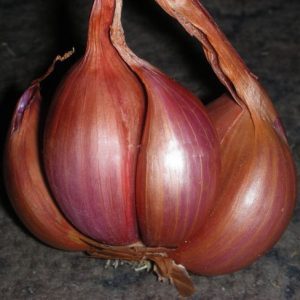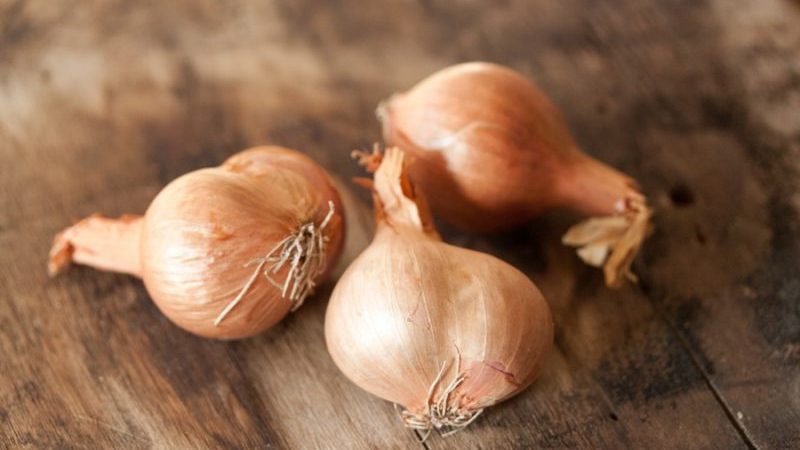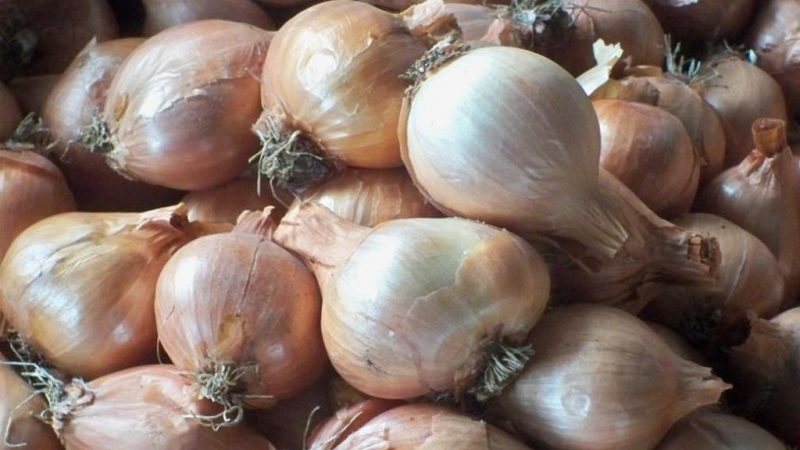When to plant the onion variety Shrike
Shrike-toothed onion is a popular variety among summer residents, known for its productivity and unpretentiousness. However, you need to pay attention to the timing and rules of planting. Read about how and when to plant the Sorokozubka variety, as well as caring for the crop in the article.
The content of the article
- Description of the Sorokozubka variety
- Chemical composition, trace elements and vitamins and beneficial properties
- The main advantages and disadvantages of the variety
- Features of planting and growing
- Harvesting and storage
- What can be the difficulties in growing
- Tips from experienced gardeners
- Reviews of the onion variety Sorokozubka
- Conclusion
Description of the Sorokozubka variety
The shrike is an increasingly popular variety of shallots. This is due to the fact that it contains many useful substances. The leaves and bulbs contain more vitamins C and B, sugars and essential oils.
Origin and development
Shallots have been cultivated for centuries. Asia is considered the homeland. Since ancient times, it has been grown in countries with warm climates. But thanks to the work of breeders, varieties suitable for colder climates were bred.
Chemical composition, trace elements and vitamins and beneficial properties
The value of the shallots is great. It is primarily used in cooking: due to the high content of nutrients, it has a positive effect on the human body.
Calorie content of the onion Magpie: there are 72 kcal per 100 g of fresh vegetable.
The nutritional value:
- proteins - 12.3 g;
- fats - 0.5 g;
- carbohydrates - 65 g;
- dietary fiber - 15.7 g;
- water - 2 g.
Shallots are rich in minerals of potassium, iron, calcium and phosphorus. Vitamins that make up the vegetable: B1, B4, B5, B6, B9, C.
Thanks to this chemical composition, the substances that make up the Magpie contribute to:
- normalizing blood pressure;
- improving digestion processes;
- healing wounds from insect bites;
- solving problems with metabolism;
- high carotene content has a positive effect on the strengthening of the eye muscles.
Ripening period and yield
Shallots are an early ripening culture. The ripening period from planting to harvest takes 70-80 days. For consumption, green leaves can be cut off within a month after planting.
The advantage of shallots and magpie in particular is that when planted, the onion begins to divide. One head makes 6-12 pieces. On average, the yield from 1 sq. m is equal to 4-5 kg of the Magpie.
Disease resistance
The variety is resistant to fungal diseases. Has a high keeping quality and in the process storage not affected by green mold rot.
Characteristics of the bulb, description of the appearance, taste

Visually, the Magpie resembles a small onion... The bulb is more elongated than a classic onion. Weight - 70 g, and length - 10 cm. Light purple onion scales adhere tightly to each other, juicy, have a pronounced taste.
The outer scales are light pink-purple in color. The green leaves of a narrow shape are bright green, covered with a faintly visible waxy coating. The feather has a mild and pleasant taste.
Which regions is best suited for
Shallots are cold hardy and easily tolerate adverse weather conditions. The advantage of the Sorokozubka variety is its drought resistance and versatility.
Due to the characteristics of the variety, it can be grown in the southern regions, in the middle lane, Siberia and the Far East.
The main advantages and disadvantages of the variety
The advantages of the variety:
- resistant to disease;
- is resistant to drought and cold.
- has a high content of nutrients;
- high yield;
- excellent taste.
Disadvantages of the variety:
- small onion size;
- picky about the ground;
- when planted in the autumn, the yield decreases.
What is the difference from other varieties
The main distinctive features of the variety:
- frost resistance;
- high taste;
- long storage juice;
- high dividing capacity of the bulb;
- early ripening.
Features of planting and growing
To obtain a high-quality harvest, preparatory work is carried out and the cultivation technology is observed. In addition, it is necessary to follow the rules of care, collection and storage.
Preparing for landing
Before planting, the following preparatory work is carried out:
- choose a landing site taking into account the predecessor;
- prepare the soil, dig up the soil and apply fertilizers;
- process the planting material by heating and soaking in potassium permanganate.
Important! Bulbs for planting are selected with a diameter of 2-3 cm and a mass of 35-40 g.
Preparing the soil for growing crops:
- with autumn plowing, fertilizer can be applied in the form of humus 4-6 kg per 1 sq. m;
- before spring planting in the process of deep digging, it is advisable to use superphosphates - 20 g per 1 sq. m, ammonium nitrate and calcium chloride, 15 g per 1 sq. m.
Ground requirements
For planting onions, choose a place with moderate humidity and good lighting.
Requirements for the soil for cultivation of the Magpie:
- loose;
- rich in humus;
- saturated with air;
- soil acidity index pH 6-7.
Important! It is not recommended to plant onions in the same place for more than three years in a row.
Predecessors
When choosing a landing site, pay attention to predecessors.
Crops after which it is recommended to plant shallots: carrots, cabbage, potatoes, tomatoes, cucumbers.
Important! Shallots are often planted between rows of already growing crops.
Timing, scheme and landing rules
Onions are planted both in spring and autumn.
The advantages of planting onions in the fall:
- getting early greenery in the spring;
- reduction of ripening time by two weeks.
In autumn, the variety is planted at sub-zero temperatures. Onions are planted throughout October. In the spring, planting work begins in the second half of April.
Important! The germination of the crop begins as soon as the soil temperature reaches + 4 ° C.
Planting scheme, distance between bulbs:
- large 20 x 10 cm;
- medium 15 x 10 cm;
- small 10 x 10 cm.
Planting rules for the Sorokozubka variety:
- furrow depth 5-6 cm, shed well before planting.
- the neck of the onion should remain 2-3 cm above the ground.
Important! In autumn, onions are planted a little deeper than in spring.
Growing features
The shrike is grown from both seeds and bulbs.
Stages of growing from seeds:
- Germinate seeds by soaking in a container with a cloth for 48 hours.
- Dry the seeds before planting.
- Sow into the ground to a depth of 1 cm.
Important! The favorable temperature for growing is about + 20⁰С, but the plant is able to withstand a decrease to -5⁰С.
The nuances of care
Cultural care consists of a standard set of activities.
Watering mode
The irrigation regime is regulated in relation to climatic conditions. In rainy weather, watering is not carried out. With prolonged drought, water is regularly watered once every two weeks, 15-20 liters per 1 sq. m.
Loosening the soil and weeding
Three timely weeding is carried out per season. Mechanical cleaning of weeds is accompanied by loosening of the upper layers of the soil.
Top dressing
During the growing period, two dressings are carried out:
- First. Fertilizers are applied when friendly seedlings appear, this happens about 14 days after planting. Top dressing is done with a solution of a mullein 1:10 of about 10 liters per 1 sq. m. Also, organic matter is replaced with chemical fertilizers. Superphosphate and ammonium nitrate are used in equal proportions of 10 g per 1 sq. m.
- Second. Carried out during the formation of bulbs. Introduce 15 g of potassium and superphosphate per 1 sq. m.
Disease and pest control
If the rules of care are not followed, as well as under unfavorable growing conditions, the Magpie is affected by various diseases.
Common diseases of onions and the fight against them:
- Cervical rot. Plants become infected in the second half of summer. Getting into the neck of the bulb, the pathogenic fungus softens the tissue, while the bulb becomes watery and an unpleasant odor appears. They use "Mikosan", "Quadris" or "Pentofag" to fight.
- Downy mildew... A pale green oval spot appears on green leaves. Over time, they affect the entire leaf area. The plant is sprayed with Profit Gold every 12-15 days until the symptoms disappear.
- Rust. In early summer, small warts form on green leaves. To combat, copper oxychloride is used, diluting it with water per 10 liters of water 40 g of the substance.
- Green mold rot... Formed during storage... Brown spots appear on the skin. When dealing with it, the bulbs are thoroughly dried before storage and the damaged bulbs are constantly rejected.
Fight against pests:
- Onion fly. If larvae are found, treat with a solution of salt at the rate of 1 glass per 10 liters of water.
- Onion nematode... The planting material is soaked in 4% formalin solution.
- Aphid. Apply "Verticillin" or folk remedies in the form of chamomile broth, pepper or potato peels.
Harvesting and storage

It is important to harvest on time. Otherwise, splinters grow and the bulbs develop green feathers.
How and when to collect
They begin harvesting the vegetable when most of the green mass turns yellow and grows. In most regions this happens in the second half of July.
Stages of harvesting the Magpie:
- Dig in with a shovel.
- Remove dirt and dirt.
- Allow to dry.
- Break the nest into individual bulbs.
Before sending the onion for storage, it is well dried, the dry leaves are cut off, leaving a thin neck 3-5 cm high.
Storage features and keeping quality of the variety
The Sorokozubka variety has a high keeping quality. For the best preservation of the crop, follow the rules for harvesting the crop.
Storage requirements:
- moderate humidity;
- airing;
- dark room;
- temperature is not higher than + 15 ° С.
Important! Seed material can be stored in the refrigerator. At low temperatures, the Magpie does not lose its properties.
What can be the difficulties in growing
Reasons for crop failure when growing a crop:
- high humidity during the growth and development of the plant;
- unsuitable place for landing;
- excessive feeding;
- wrong choice of predecessor;
- a high percentage of diseases and pests.
Tips from experienced gardeners
When growing a magpie, consider all the features of the variety.
Experienced gardeners recommend:
- Do not apply fresh manure and high doses of nitrogen fertilizer directly under the onion.
- Avoid thickening of crops. The sowing area should be well ventilated.
- Start harvesting when the bulb has formed and the leaves are dead, but not yet dry.
- Collect in dry weather. Dry the bulbs well in a ventilated area.
- Store in a dry, ventilated place.
Reviews of the onion variety Sorokozubka
The Sorokozubka variety is popular with summer residents due to its yield and early maturity.
Vitaly, Saransk: «I planted this variety. Has grown a little more than 10 cm, and the ends began to dry. But in general I liked the bow. Grew up evenly as a green carpet. Two onions - and you get an excellent bunch.The only drawback is that cleaning problems arise due to the small size. "
Igor, Volokolamsk: “A very fruitful vegetable. I have not heard of this type of onion before. But somehow I was driving to the dacha in the spring and accidentally bought it. I planted it according to all the rules. All the bulbs sprouted to my surprise. The harvest was good. For food, this onion is still too small. No, when it's still green, the arrows are good. What is especially pleasing - it is perfectly stored in winter at room temperature. "
Conclusion
The Sorokozubka variety is distinguished by an early growing season and excellent taste. Observance of planting dates contributes to obtaining a high and high-quality harvest. And proper care and harvesting of crops is a guarantee of good keeping quality and the preservation of nutrients in the vegetable.
Is it possible not to dig up the bulbs in the fall, but leave them in place until next year?